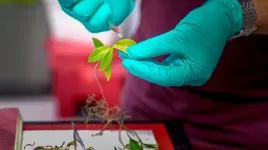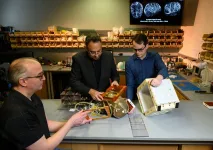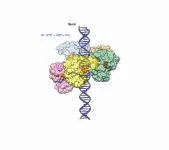(Press-News.org) MUSC Hollings Cancer Center researchers are finding solutions to the aging-related changes that reduce anti-cancer immunity. Besim Ogretmen, Ph.D., and colleagues found a novel link between aging, metabolism and anti-cancer T-cell function. Their work, published in Cell Reports, sheds light on an important pathway that cannot be ignored during cancer treatment.
Two broad questions in cancer research are: How can cancer treatments be improved, and what is the link between cancer and aging?
"We know that the protective T-cell response deteriorates with age. Mitochondrial function is now thought to be one of the central regulators of the aging process. Our experiments connected the dots with what was previously shown and highlighted some surprising and important pathways," said Ogretmen, who is the SmartState Endowed Chair in Lipidomics and Drug Discovery.
All cells in the human body, except red blood cells, contain structures called mitochondria. Mitochondria are a cell's central powerhouse -- they produce the chemical energy necessary for survival. Ogretmen's prior studies showed that a particular type of fatty molecule, called ceramide, causes mitochondrial dysfunction in cancer cells. In terms of cancer, mitochondrial dysfunction is thought to be a good thing since it weakens the cancer cells.
However, mitochondrial dysfunction might not be completely beneficial for cancer treatment. "We know that increased ceramide signaling is linked with aging, but it is important that we understand if this is also occurring in immune cells. Immunotherapy is becoming an increasingly important part of cancer treatment, so we must better understand the immune system in older people," he said.
Aging stress produces the bioactive sphingolipid called ceramide. This lipid promotes mitochondrial dysfunction by a biological mechanism called mitophagy, where the broken mitochondria are selectively destroyed to kill cancer cells. However, scientists do not know if T-cells use this same pathway or if their immune functions are changed by ceramide signaling.
The results, which were surprising, showed ceramide signaling weakens anti-tumor T-cells. The data showed that:
Aging decreases T-cell survival and function.
Aging stress induces mitophagy in T-cells.
Blocking certain ceramide molecules improves the anti-tumor function of aging T-cells.
"What this tells us is that ceramides need to be carefully controlled in a cancer setting," said Ogretmen. This is particularly important because there are several FDA-approved drugs, such as FTY720 for multiple sclerosis, that increase ceramide signaling. Systemic increase of ceramide signaling in cancer patients may be harmful because it weakens the anti-cancer function of the patient's immune system, he said.
Using multiple molecular methods, the team observed that T-cells from old mice, which were equivalent to approximately 50- to 60-year-old humans, had more ceramide accumulation in their mitochondria, which led to dysfunction. These cells had lower anti-tumor functions in cell culture and in cancer animal models. This biological pathway was confirmed by blocking ceramide signaling. Inhibiting ceramide metabolism by genetic or pharmacological means prevented mitophagy and restored the anti-cancer function of the aging T-cells, making them perform like younger counterparts.
"Our work was aided by a really strong team of collaborators and funding support from Hollings Cancer Center. The Team Science Award allowed us to generate this data, which has developed into something larger. We just resubmitted an NIH program project grant that focuses on the role of sphingolipids in T-cells and cancer," he said.
The team will continue to piece together the biological pathways and processes to ensure that these findings are applicable to humans. The next step is to understand how aging induces ceramide stress. In general, stress can invoke dormant cancers, and this may be related to ceramide signaling.
"Understanding the mechanism of ceramides and lipid metabolism in T-cells has broad implications in aging and immune cells in general. Our work is important because it allows us to understand autoimmune diseases and infections more fully, not just cancer." There is also a potential link to lifestyle choices and stress, which may accelerate the aging process of T-cells, he said.
INFORMATION:
Funding: NIH (CA214641, DE016572, and P01 CA203628) and SmartState Endowment in Lipidomics and Drug Discovery.
About MUSC
Founded in 1824 in Charleston, MUSC is the oldest medical school in the South as well as the state's only integrated academic health sciences center with a unique charge to serve the state through education, research and patient care. Each year, MUSC educates and trains more than 3,000 students and nearly 800 residents in six colleges: Dental Medicine, Graduate Studies, Health Professions, Medicine, Nursing and Pharmacy. The state's leader in obtaining biomedical research funds, in fiscal year 2019, MUSC set a new high, bringing in more than $284 million. For information on academic programs, visit musc.edu.
As the clinical health system of the Medical University of South Carolina, MUSC Health is dedicated to delivering the highest quality patient care available while training generations of competent, compassionate health care providers to serve the people of South Carolina and beyond. Comprising some 1,600 beds, more than 100 outreach sites, the MUSC College of Medicine, the physicians' practice plan and nearly 275 telehealth locations, MUSC Health owns and operates eight hospitals situated in Charleston, Chester, Florence, Lancaster and Marion counties. In 2020, for the sixth consecutive year, U.S. News & World Report named MUSC Health the No. 1 hospital in South Carolina. To learn more about clinical patient services, visit muschealth.org.
MUSC and its affiliates have collective annual budgets of $3.2 billion. The more than 17,000 MUSC team members include world-class faculty, physicians, specialty providers and scientists who deliver groundbreaking education, research, technology and patient care
About MUSC Hollings Cancer Center
MUSC Hollings Cancer Center is a National Cancer Institute-designated cancer center and the largest academic-based cancer research program in South Carolina. The cancer center comprises more than 100 faculty cancer scientists and 20 academic departments. It has an annual research funding portfolio of more than $44 million and a dedication to reducing the cancer burden in South Carolina. Hollings offers state-of-the-art diagnostic capabilities, therapies and surgical techniques within multidisciplinary clinics that include surgeons, medical oncologists, radiation therapists, radiologists, pathologists, psychologists and other specialists equipped for the full range of cancer care, including more than 200 clinical trials. For more information, visit hollingscancercenter.musc.edu.
Thursday, June 3, 2021, CLEVELAND: A Cleveland Clinic study shows that survivors of COVID-19 who have moderate or severe obesity may have a greater risk of experiencing long-term consequences of the disease, compared with patients who do not have obesity. The study was recently published online in the journal of Diabetes, Obesity and Metabolism.
Multiple studies have identified obesity as a risk factor for developing a severe form of COVID-19 that may require hospital admission, intensive care, and ventilator support in the early phase of the disease. Obesity, which is a complex disease caused by multiple factors, is associated with an increased risk for cardiovascular ...
DURHAM, N.H.-- Bears are known for being devoted and protective of their baby cubs, but research from the University of New Hampshire shows that they may also play a significant role in shielding gray fox from predators like coyotes, who compete with the fox for food and space. The research is one of the first studies to show how black bears provide a buffer to allow other, smaller carnivores to safely co-exist.
"Even though black bears and coyotes are the two most common carnivores in North America, we're still learning how they affect the ecosystems around them," said Rem Moll, assistant professor of wildlife ecology and lead author ...
The fabrication device for the battery revolution looks quite unconspicuous: It is a modified, commercially available 3D printer, located in a room in the Empa laboratory building. But the real innovation lies within the recipe for the gelatinous inks this printer can dispense onto a surface. The mixture in question consists of cellulose nanofibers and cellulose nanocrystallites, plus carbon in the form of carbon black, graphite and activated carbon. To liquefy all this, the researchers use glycerin, water and two different types of alcohol. Plus a pinch of table salt for ionic conductivity.
A sandwich of four layers
To build a functioning supercapacitor from these ingredients, four layers are needed, all flowing out of the 3D printer one after the ...
Left- or right-handedness is a symmetry property that many macroscopic objects also exhibit and which is of immense importance, particularly for the bioactivity of organic molecules. Chirality is also relevant for physical or chemical properties such as optical activity or enantioselectivity of crystalline solids or their surfaces. In the case of chiral metallic phases, unconventional superconductivity and unusual magnetic ordered states are linked to the chirality of the underly-ing crystal structure. Despite this connection between chirality and the properties of a material, detection is often difficult because left-handed and righthanded ...
The expansion of wind energy in the German Bight and the Baltic Sea has accelerated enormously in recent years. The first systems went into operation in 2008. Today, wind turbines with an output of around 8,000 megawatts rotate in German waters, which corresponds to around eight nuclear power plants. But space is limited. For this reason, wind farms are sometimes built very close to one another. A team led by Dr. Naveed Akhtar from Helmholtz Zentrum Hereon has found that wind speeds at the downstream windfarm are significantly slowed down. As the researchers now write in the journal Nature Scientific Reports, this braking effect results in astonishingly large-scale low wind pattern noticeable in mean ...
Neurodegenerative disorders that cause dementia increase the risk of contracting severe COVID-19 and dying from the disease. For people with Alzheimer's the risk is three times greater. It can be six times greater if they are over 80, according to a study conducted in Brazil by researchers at the University of São Paulo (USP) and Butantan Institute in partnership with colleagues at the Federal University of Rio de Janeiro (UFRJ).
An article on the study, which was supported by FAPESP, is published in Alzheimer's & Dementia: The Journal of the Alzheimer's Association.
"We found that all causes of dementia are risk factors for severity and death in COVID-19 and that these ...
ITHACA, N.Y. - Water regulation in leaves is vital to a plant's health, affecting its growth and yield, disease susceptibility and drought resistance.
A breakthrough technology developed by Cornell University researchers uses nanoscale sensors and fiber optics to measure water status just inside a leaf's surface, where water in plants is most actively managed.
The engineering feat provides a minimally invasive research tool that will greatly advance the understanding of basic plant biology, and opens the door for breeding more drought-resistant crops. The technology could eventually be adapted for use as an agronomic tool for measuring water status in crops in real time.
The study in maize plants, "A Minimally Disruptive Method for Measuring Water Potential In-Planta ...
Sickle Cell Disease (SCD) is a genetically inherited group of red blood cell disorders. END ...
DURHAM, N.C. - A group of researchers have discovered the detailed inner workings of the molecular motor that packages genetic material into double-stranded DNA viruses. The advance provides insight into a critical step in the reproduction cycle of viruses such as pox- herpes- and adeno-viruses. It could also give inspiration to researchers creating microscopic machines based on naturally occurring biomotors.
The research was conducted by scientists from Duke University, the University of Minnesota, the University of Massachusetts and the University of Texas Medical Branch (UTMB). The results appear online in a trilogy of papers published in Science Advances, ...
WHO: JoAnn Manson, MD, DrPH, Physician and Epidemiologist, Division of Preventive Medicine, Brigham and Women's Hospital; co-author of a new Perspective piece published in The New England Journal of Medicine (pdf attached)
WHAT: Less than 50 years ago, a U.S. Supreme Court decision paved the way for women's use of contraception irrespective of marital status, and a year later, in 1973, the Court ruled in Roe v. Wade that women have a right to legalized abortion. In recent decades, clinical researchers and policymakers alike have made important strides ...






